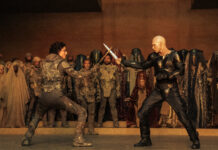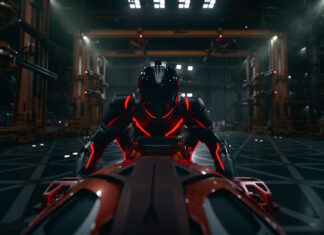This post contains affiliate links and our team will be compensated if you make a purchase after clicking on the links.
Gazing silently out a window on a stark urban landscape, Los Angeles, Ryan Gosling, known in this story only as Driver, sees a mirror reflection of himself. A man hidden behind a mask, he is as layered and unpredictable as the city in which he abodes. Driver as a character is the very thing that ”Drive” is as a movie – quiet, haunting, methodical, with a hint of rabid violence that is hidden behind a veil of unadulterated goodness.
Check-Out the “Drive” Photo Gallery!
“Drive” is the type of film that grips you immediately with a soft spoken energy, and refuses to let go. From there, it builds, slowly but surely, until bursting with tremendous bouts of violence at the halfway mark. The story as a whole, is familiar, but it is the minute details that are resiliently fresh. Driver (Ryan Gosling) is a loner living in Los Angeles, a man of three distinct personalities. The majority of his time is spent working for his good friend Shannon (Bryan Cranston) as a masterful car stunt driver in Hollywood. When movie work is slow, he fixes cars at Shannon’s garage. But as the movie begins, we find Driver in a far removed environment, moonlighting as the getaway car driver for two men carrying out a heist. This is the the main show — Driver sits patiently, his watch ticking as the allotted time winds down. The thieves return to the car from a darkened warehouse, carrying duffle bags of loot. As Driver takes off, a Dodgers game plays lightly on the car stereo, seemingly narrating Driver’s every spectacular maneuver as he speeds along the city streets, eluding police, a stoic gaze fixed permanently upon his face.
Director Nicolas Winding Refn takes the time necessary to allow this initial vision of Diver to settle in. We witness him going through the motions – working, driving, and finishing his days spending time watching TV in solitude. His boss, Shannon introduces him to a friend, Mr. Bernie Rose . He wants Driver to race a car, sponsored by Mr. Rose. Driver shows his talents on the track and Rose is impressed. Driver cordially shakes hands, barely uttering a word. Rarely does he speak out loud, his bottomless blue eyes communicating more than words ever could.
One day, a young woman, Irene (Carey Mulligan) and her son Benicio (Kaden Leos) move in down the hall in Driver’s apartment building. The two meet, laughing nervously at each other, and an instant unspoken connection is cemented between them. Every time Driver sees Irene, the edges of his mouth twitch into a smile. He begins to spend time with Benicio, willingly taking up the role of protector and helpful neighbor. There is a spectacular harmony between Gosling and Mulligan that cannot be ignored. The relationship between the two is so utterly minimal, yet feels as if the two are experiencing a sacred moment every time they share screen time. For all the praise Ryan Gosling received for his chemistry with Michelle Williams in last year’s smoldering,”Blue Valentine,” his work with Mulligan here strikes as even more perfect and complete.
Just as soon as Driver begins to grow trusting of Irene, her husband, Standard returns early from prison. Standard wants to redeem himself, and Driver readily steps back to give Standard reign of his family. But when he finds out that Standard has a debt to pay, one final job to rid himself of his criminal life, Driver agrees to navigate the getaway vehicle. This is a picture of the deep sacrificial spirit Driver possesses, willing to protect Irene when there is no payback awaiting him at the end. The trip to get the money Standard owes ends horrendously, and instead, Driver is thrown into a spiraling series of events of inexplicable brutality.
Driver as a character could have easily fallen into a trench clichéd attributes. But Ryan Gosling so subtly balances times of silence with the moments of inexplicable rage, that his creation of Driver never once appears dramatically engineered. There is never a bit of backstory given to the character, we simply see him in the here and now. It is a powerful risk, because it requires the audience to read beneath Driver’s skin and interpret his true motivations and personality. As he embarks on his rampage to secure justice for himself and those he cares about, the audience must trust Driver’s instincts, or the entire story begins to disintegrate. And we do, so much so, that by the film’s end, you feel as one with Gosling’s character, till the very last minute when he drives into the dark oblivion.
The singular aspect of “Drive” that makes it so overwhelmingly powerful is Nicolas Winding Refn’s signature orchestration of the entire film. There is an unforgettable scene where Driver and Irene ride in an elevator to their apartment floor. A man stands across from them, waiting to attack. Time freezes, the score climaxes, and Driver kisses Irene with abandon in slow motion before inflicting obscene violence upon the man. This artistic touch is all Refn, and he never allows the film to fall out its constant state of surreal being. It is a scene like this that leaves very little doubt that we are witnessing the work of a true film master.
“Drive” is an immediate classic. The film moves and breathes with an authentic story and style that feels timeless. Everything in the film is just below the surface, but rather than causing us to miss it, director Nicolas Winding Refn creates the ideal rhythm, allowing the audience the liberty to absorb and reflect within the viewing experience. The film relies more on visuals than actual story, but we never tire from grandeur of the Los Angeles cityscape or the contrasting island of alienation found within the tight spaces of car interiors. As the movie opens, Gosling begins narrating by saying ”There are 100,000 streets in this city…” Just like Driver, we all find ourselves on a slightly different route than the next person. And that, is the true beauty of existence.
Discover more from Socalthrills.com
Subscribe to get the latest posts sent to your email.











